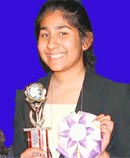
|
|
Maharishi School students study water quality, sweep top awards at State Science Fairs Maharishi School sophomores Pearl Sawhney and Minna Mohammadi recently won the Iowa Junior Academy of Science award, which entails an all-expense-paid They researched the link between farm feeding practices and the presence of phosphorus in the water in the Jefferson county area. In March they also swept the top prizes at the earlier Eastern Iowa State Science Fair as well as the State Science and Technology Fair of Iowa. Their project, entitled "Farm Feeding Practices: Exploring Solutions for Environmental Sustainability," also won a free trip to participate at the Intel International Science Fair in San Jose with their teacher and mentor, Dr. Mousumi Dey, later this month. The students tested animal feed for unbound phosphorous, which is important for bone growth, and for phosphorous bound to phytates, which is indigestible and excreted by the animals. "Manure is applied to fields as fertilizer, so pollution occurs when bound phosphorous enters local streams with run-off," Ms. Sawhney said. This phosphorous increases the algae and phytoplankton populations, which then use up oxygen in the water when they decompose. This lowers the oxygen levels in the water and creates an uninhabitable environment. She said this type of pollution has created a dead zone in the Gulf of Mexico the size of New Jersey. The students found that water downstream from organic farms had the lowest phosphorus content, and that water downstream from CAFOs (concentrated animal feeding operations) had the highest phosphorus. "This indicates that organic farms, of the farms we tested, have the least negative effect on nearby water bodies," Ms. Mohammadi said. "We plan to continue our research and extend it to other counties." At the state science fair they won four first-place awards, a grand prize award, and several special awards. Some carried cash prizes as high as $1,000. The two students were sponsored in part by Jefferson County Farmers and Neighbors association. They received mentoring and testing materials from the USDA. Dennis Dey and Rajeev Sawhney provided additional mentoring. The project impressed and intrigued judges because it's an area not previously researched, Dr. Dey said. They tested three different types of farms: confined animal feeding operations, conventional farms, and organic farms. "The students performed multiple tests," Dr. Dey said. "All the results were highly statistically significant. The girls collected water under extremely difficult conditions to minimize errors. Also, they took great care and every precaution to get the most accurate results." The students said their goal was to find a local solution to a global problem. But the research wasn't without its challenges. "We didn't realize what we were getting into," Ms. Mohammadi said. "It was difficult, cold, muddy work collecting samples." The Maharishi School Head, Dr. Richard Beall said, "We are extremely proud of the high level of scientific research that Minna and Pearl produced. As much as their accomplishments, we're also proud of the social significance of their topic. This research bears real consequence on public health."
© Copyright 2010 Maharishi University of Management
|
|



